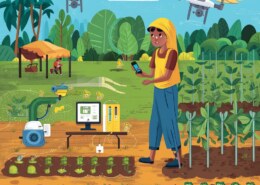Roadmap for Answer Writing 1. Introduction Define Integrated Farming System (IFS) and its purpose. Emphasize its role in creating a balanced, sustainable agricultural ecosystem. Fact: IFS combines various farming practices such as crop production, animal husbandry, and forestry to enhance sustainability. (Source: Agricultural Research ...
Model Answer Introduction The 'Digital India' program, launched in 2015, aims to create a robust digital infrastructure to empower rural communities and enhance digital literacy, particularly in the agricultural sector, where 70% of India's population resides and agriculture is the primary livelihooRead more
Model Answer
Introduction
The ‘Digital India’ program, launched in 2015, aims to create a robust digital infrastructure to empower rural communities and enhance digital literacy, particularly in the agricultural sector, where 70% of India’s population resides and agriculture is the primary livelihood for 50% of the population. Here’s how the program can help farmers improve farm productivity and income:
Digital India Program and Farm Productivity
- Access to Information: Farmers can access real-time data on market prices, weather forecasts, and soil health, enabling them to make informed decisions that enhance yields and reduce risks.
- E-Commerce Platforms: The program facilitates direct sales through e-commerce, allowing farmers to sell produce directly to consumers, thus bypassing intermediaries and increasing their income.
- Tailored Recommendations: Digital tools can provide personalized advice based on crop type, weather conditions, and market trends, helping farmers optimize their practices.
- E-Agriculture Services: Online services such as soil testing and crop insurance are made available, improving the quality of produce and minimizing crop failure risks.
- Direct Cash Transfers: The program supports direct cash transfers to farmers, replacing traditional subsidies, which helps reduce debt burdens and encourages investment in farming.
- Growth of Start-ups: Digital India fosters the growth of agri-tech start-ups, providing farmers with innovative solutions for crop management, market intelligence, and access to credit.
- Social Media Utilization: Platforms like Digital Green enable farmers to share best practices through participatory videos, enhancing knowledge transfer in a cost-effective manner.
Steps Taken by the Government
- e-NAM: The National Agriculture Market (eNAM) is an online trading platform that connects farmers with buyers, improving price transparency and market access.
- BharatNet: This initiative aims to provide high-speed internet connectivity to all gram panchayats, enhancing communication and access to digital services.
- National Mission on Agricultural Extension and Technology: This mission strengthens agricultural extension services to deliver modern technologies and practices to farmers.
- AgriMarket App: This mobile application keeps farmers updated on crop prices, helping them avoid distress sales.
- E-Governance Initiatives: The government has launched various portals, including the farmer portal and m-Kisan portal, to provide essential information and support to farmers.
Conclusion
The Digital India program holds significant promise for enhancing farmers’ livelihoods by providing access to vital information and services that improve productivity and reduce risks. By empowering rural youth and facilitating equitable market access, it aims to transform the agricultural landscape in India.
See less

Model Answer Introduction Integrated Farming System (IFS) is an innovative agricultural approach that combines various farming practices, such as crop production, animal husbandry, and forestry, to create a sustainable ecosystem. By ensuring that the waste from one process serves as an input for anoRead more
Model Answer
Introduction
Integrated Farming System (IFS) is an innovative agricultural approach that combines various farming practices, such as crop production, animal husbandry, and forestry, to create a sustainable ecosystem. By ensuring that the waste from one process serves as an input for another, IFS aims to enhance agricultural productivity while promoting environmental sustainability.
Key Benefits of Integrated Farming System
1. Resource Optimization
IFS significantly reduces the reliance on chemical fertilizers by recycling nutrients within the farming ecosystem. This not only lowers input costs but also minimizes chemical residues in food and soil.
Fact: IFS aids in pest and weed control by maintaining a balanced ecosystem, thereby reducing the need for chemical interventions.
2. Waste Reduction
By utilizing by-products from one subsystem as inputs for another, IFS minimizes waste. This environmentally friendly approach not only cuts costs but also enhances farm sustainability.
Fact: The practice of recycling waste within IFS helps in reducing financial burdens on farmers.
3. Environmental Benefits
IFS promotes sustainable resource use, reduces the ecological footprint of farming, and enhances biodiversity. The system ensures that natural resources are used efficiently, thereby mitigating environmental degradation.
Fact: IFS contributes to agroecological equilibrium, fostering resilience in farming systems.
4. Economic Stability
Multiple farming activities on the same land provide year-round employment opportunities, ensuring a consistent income flow for farmers. This diversification is crucial for financial security, especially given the unpredictability of monsoons.
Fact: IFS offers alternative income sources through activities like animal husbandry and horticulture, thereby reducing risk for farmers.
5. Nutritional Security
By producing a diverse range of products—cereals, poultry, fish, and fruits—IFS addresses malnutrition associated with single-crop diets. This diversification is key to improving the nutritional status of communities.
Conclusion
The Integrated Farming System is instrumental in sustaining agricultural production by enhancing resource efficiency, promoting diversification, and supporting livelihoods. For India to achieve its goal of doubling farmers’ incomes while ensuring sustainability, a well-designed IFS must be adopted on a regional basis. This approach not only secures agricultural outputs but also fosters environmental health.
See less